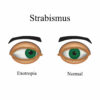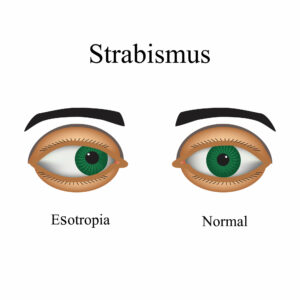
All About Crossed Eyes and Lazy Eye
Strabismus and amblyopia are two very closely linked eye conditions that affect our eye muscles. Crossed and lazy eyes are mostly found in children; however, when left untreated, they can become a permanent condition in adult eyes.
Strabismus and amblyopia are often confused and people have a hard time telling the two apart. Both conditions affect the eye muscle and cause similar symptoms. So, what’s the difference?
Well, today we have our comprehensive guide packed will all you need to know about crossed and lazy eyes: what they are, how they are treated, and what causes them.
Strabismus (Crossed Eyes)
Strabismus, better known as crossed eyes, is a condition that causes the eyes to cross. However, the name is somewhat misleading. Technically, and we mean very technically, strabismus is the term used to describe the turning of the eyes.
Words, as we are all aware, constantly evolve and meanings change. The word awful used to mean to be worthy of awe. I don’t know about you, but the last time I used the word awful was to describe bad weather.
All this to say, though the word strabismus technically refers to the turning of the eye (in which case it would encompass amblyopia), we have a tendency to associate it with crossed eyes.

Crossed eyes are even a misleading term because it can refer to the eyes either crossing inward (esotropia) or drifting outward (exotropia).
The bottom line is that having crossed eyes doesn’t always mean they look crossed. In fact, some technically crossed eyes drift in completely different directions. One could be pointed up while the other one points down.
Symptoms and Causes
Symptoms of strabismus are very easy to spot because it is visible to us. We can clearly see when a child has strabismus because the eyes will not be aligned. They will drift inward, outward, or maybe in completely different directions. Either way, this is a clear sign of crossed eyes.
Many babies are born cross-eyed but grow out of it as the eyes finish developing. On the other side of that, some babies don’t grow out of it. Special treatment is required to fix this early so that the eyes don’t permanently remain that way.
Crossed eyes can be either caused by weak muscles or a neurological condition. Sometimes the eye muscles just aren’t strong enough to keep the eyes aligned. However, sometimes it can be caused by the brain misaligning the eyes for some reason.
Genetics also play a large role in strabismus. If a parent or both are cross-eyed, then their child is more likely to be born with the same condition. It isn’t a guarantee, however. Sometimes the gene is passed down and sometimes it is not. There isn’t a way to really tell until the baby is born.
Treatments: Children and Adults
Because the eyes are still developing when a baby is born, it makes treating strabismus much easier. It’s easier to mold the eyes and get them to realign themselves. In adults, however, it can be more difficult.
In children, common treatments include wearing eye patches, using special eye dr,ops and wearing the appropriate eyewear to help the brain and eye muscles communicate better. Sometimes, in severe cases, parents have their children undergo a surgical procedure; however, this is very risky and is not recommended.
For adults, treatments usually include personalized vision therapy programs. When an adult has crossed eyes, they will likely stay like that forever. The appearance of the eyes may not improve, but their eyesight can improve drastically using vision therapy.
Again, surgery is also an option for adults with crossed ees, but rarely do people actually need it. The only benefit it brings to most is fixing the appearance of the eyes. It’s invasive and does not improve your vision.
Amblyopia (Lazy Eye)
Amblyopia, better known as lazy eye, is similar to strabismus in that there is one eye that drifts while the other remains in line. Lazy eye is the most common vision condition among children and is very treatable if treated early during childhood.
The key difference between laeyeseye and crossed eyes is that lazy does not refer to the misalignment of the eye. Instead, it refers to the vision impairment that is caused the by eyes misaligned.
When someone has a lazy eye it means that their brain is actively ignoring the weaker eye, and chooses to only receive images from the stronger eye. Where strabismus is caused by weak muscles, amblyopia is caused by one eye being tuned out by the brain.
Symptoms and Causes
Symptooffor amblyopia are not always easy to see. Sometimes an eye will drift to the side, while the other remains in line. But in some other cases, the eyes will be perfectly aligned, but the brain will still prefer the stronger eye.
If you suspect your child has amblyopia but shows no physical signs, there is a simple at-home test you can try. Simply cover one of their eyes and then cover the other. Ask them what they see when the right eye is covered and what they see when the left eye is covered. If they have trouble seeing when one eye is covered, but not the other, they may have amblyopia.
Several things can cause amblyopia. The most common cause is strabismus. Not everyone with strabismus will experience amblyopia, but it is very common. The brain will begin to favor the stronger eye and ignore the weaker one, leaving that one to drift even further.
Another thing that can cause amblyopia is uneven refractive errors in each eye. A child with a refractive error will have perfectly aligned eyes, but if one eye sees better than the other, then the brain will ignore the weaker eye.
Treatment for Crossed and Lazy Eyes
Treating amblyopia in children is fairly simple. It can be done by covering the stronger eye and forcing the brain to use the weaker eye until it is no longer weak. The brain is forced to adapt when it only has the option to use the weaker eye.
All children are different and some will overcome the condition more quickly than others. It generally takes a few months of covering your child’s eyes every day with an eyepatch for at least 30 minutes. There are a variety of techniques you can try to help treat children experiencing crossed or lazy eyes.
For adults, unfortunately, there is no cure. However, like with strabismus, there are plenty of vision therapy programs available to help improve your vision in the weak eye.
If you or your child has strabismus or amblyopia, talk to your doctor to find the best treatment. Regular eye exams can help you to make sure you have someone to talk to should the situation arise.
Our Rebuild Your Vision Ocu-Plus Formula Contains All 17 Vitamins, Minerals, and Herbal Supplements to Improve Your Eye Health!




I appreciate your article and would like to add that vision therapy is not just recommended for adults, but also for children. It’s important to find a developmental optometrist who specializes in vision therapy. These optometrists have done training and been certified by the College of Optometrists in Vision Development. Often patching is not the recommendation, or is done in a more limited way than the regular eye doctor would recommend. You can find a developmental optometrist at covd.org. Vision therapy has been life changing for our family. I blog about it at http://www.healingmysight.com.
Recently I came to know that my 6 years old has refractive amblyopia in her left eye. She has started wearing glasses and patching excercise. The Optometrist recommended 3-4 hours of patching exercise. Can she get rid of glasses after the treatment of her lazy eye?
Very educative. Can Glaucoma be treated surgically with modern method?
How get your Ultimate Vision Supplements (Ocu-Plus Formula?
Click the ‘Rebuild Your Vision Ocu-Plus Formula’ in our Store to order the Ocu-Plus Formula.
My son developed acquired esotropia (strabismus followed by amblyopia) at age 3 after a fever. After trying glasses, it was easily corrected by day surgery to adjust the eye muscles with full binocular vision achieved. Dr Gole in Brisbane Australia is amazing and has done thousands of procedures on paediatric patients over quite a few decades. He told me it was much more common before the introduction of the measles vaccine.